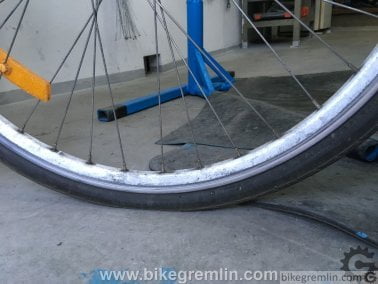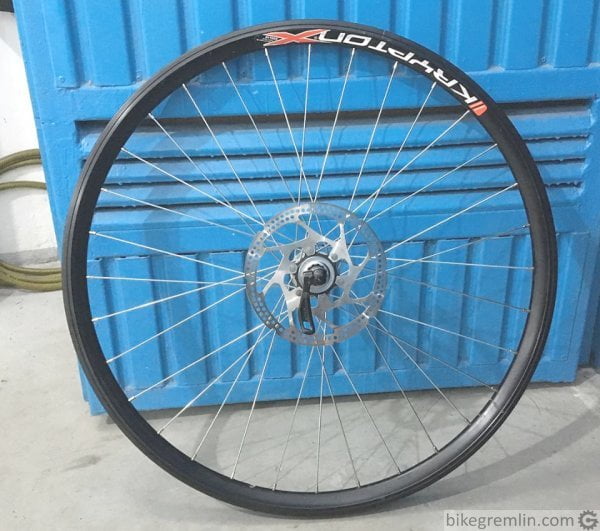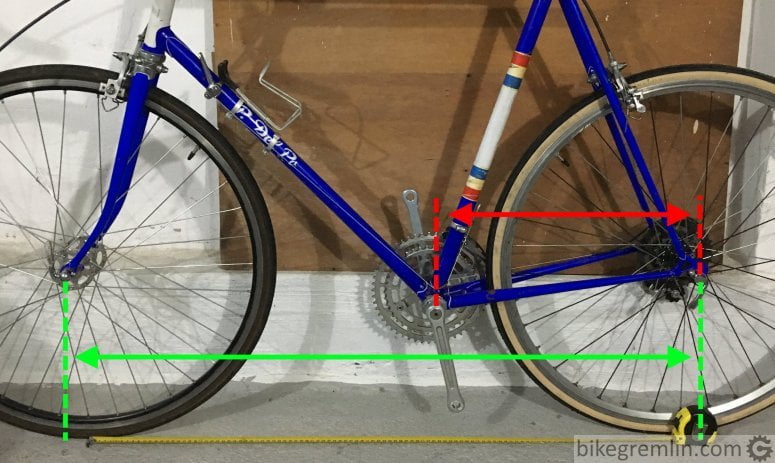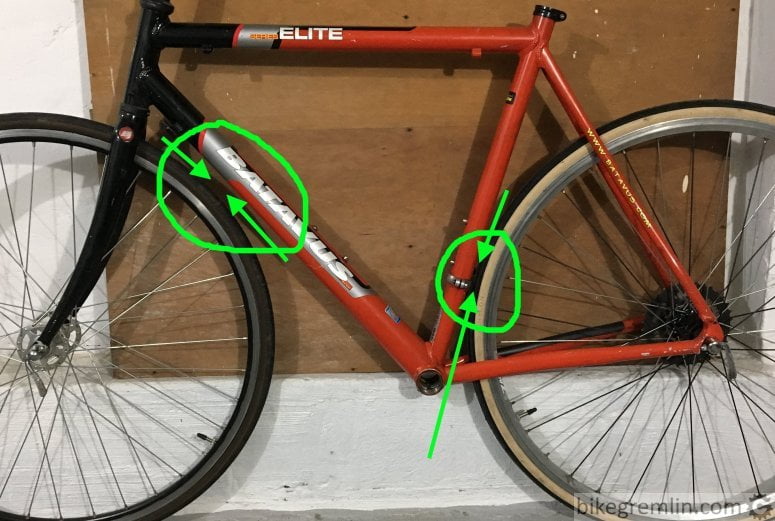This post deals with comfort of a bicycle, in terms of dampening road shocks and vibrations.
For other comfort-related topics, separate posts explain setting up a comfortable riding position, adjusting handlebar height and angle and setting up flat bars (MTB/hybrid/city bike) and drop (road bike) bars.
Related to frames themselves, I wrote about bicycle frame geometry (in terms of handling) and about bicycle frame design (in terms of strength and weight).
Contents:
0. Introduction – what affects bicycle comfort
1. Tyres
2. Wheels
3. Suspension (shock absorbers)
4. Frame
…4.1. Un/comfortable frame geometry
…4.2. Frame material and tubing design
5. Stems and seatposts
6. Saddle, handlebars, grips/bar tape
7. Placebo
0. Introduction – what affects bicycle comfort
When listening to cyclists, or reading cycling Internet forums, one can often hear/read that there are frames, handlebars, tyres and even wheels (as rim + spokes) that are uncomfortable. Or comfortable, if it’s a praise. Some of such claims are a result of good understanding of the equipment, with thousands kilometres of riding it. Others are full of myths and wrong deductions. This post gives an objective explanation how some of the main bicycle components deal with bumps, potholes and road vibrations and what to look for in order to increase comfort. Order will be from the bottom (the surface ridden on), towards the top.
1. Tyres
The main function of air-filled tyres is amortisation of road shocks and vibrations. Tyres flex, conforming to road irregularities, absorbing them.


For more comfort, choose wider tyres, with good quality side walls, inflated to optimal pressure. Post about tyre width explains this in more detail. Tyre width and quality has by far the greatest affect on ride comfort (and grip, but that’s another topic – see here for explanation of slick and winter bicycle tyres advantages). It can even be said that all the other component affects, combined together, can hardly match the tyre affect. In addition to this, tyres are the first thing contacting the ground, so their absorption leaves less job for other components and improves bicycle handling.
2. Wheels
Widespread cycling myth of “comfortable wheels”. From many cyclists you can hear that this and this rim, or spoke pattern is a very comfortable/uncomfortable. Why is this a myth? Rim flexing at the ground contact patch is in the range of the paper sheet thickness. A softest rim might compress by a whole two sheets of paper when hitting a bump! 🙂 That is at most 0.2 mm movement – compared to tyre flex that can reach several centimetres. So, tyre affect is about a 100 (hundred!) times greater!
It should be noted that spoke tension, type and lacing pattern have no measurable affect on comfort. They affect wheel’s strength and durability, but not comfort.

Picture 2
3. Suspension (shock absorbers)
Suspension definitely increases comfort, handling and tyre grip. However, the downsides of suspension are more weight, higher price, and required maintenance (time + money). It is definitely more efficient to achieve the desired comfort level using other methods, unless suspension is necessary. For more information on weighing suspension pros and cons, see the detailed explanation of bicycle suspension benefits and downsides.
4. Frame
Bicycle frame has a great impact on bicycle handling and comfort. Comfort is affected both by frame geometry and frame material (and construction). This text disregards frame geometry (and effective frame size) in terms of fitting, but deals with it only in terms of shock damping.
4.1. Un/comfortable frame geometry
Frame geometry impact on shock absorption far outweighs the influence of frame material, in spite of all the hype about “comfortable carbon frames/forks”. Important dimensions are wheelbase length and chainstay length.

Picture 3
Picture 3 shows the important dimensions. Chainstay length influences comfort a lot more than wheelbase length (which still has more effect than frame material). Short chainstay means the rider is practically sitting on top of the rear wheel, and every bump and tilt goes straight to the saddle/rider. Long chainstays, with a longer wheelbase, place the rider between the two wheels, and greatly reduce road shocks impact on the rider.
Comfortable ride and high speed (downhill) stability is achieved with over 100 cm long wheelbase and around 45 cm long chainstays.
Modern frames are sold with buzzwords such as “aggressive”, “responsive” etc. Whatever that really meant. Not to forget the carbon frame buzzword “vertically compliant, laterally stiff”. Since sales are boosted by lower weight, frames are made to be as small as possible (smaller size = lower weight), chainstays and wheelbases are made to be as short as possible – providing just enough room to fit the tyres, without scratching the frame. With a: “light, aggressive and responsive” sticker. Picture 4 shows a typical modern road bike frame (MTB-s are not exempted from this either).

Picture 4
When a frame is designed as shown in picture 4 (under 100 cm wheelbase and around 41 cm long chainstays), it takes all the available tricks to make it not too uncomfortable and with a decent handling at high speeds. This is where carbon fibre, tubing shapes and many other marketing buzzwords come into play, as explained in the next heading:
4.2. Frame material and tubing design
Frames are usually made of metals (aluminium, steel and titanium), or carbon fibres. An ideal frame, whichever material it were made from, would have the following properties:
- It wouldn’t bend at all when pedalling (no sideways bending).
- It would bend (vertically) when hitting bumps, to absorb them.
Metal tubes can not be made so they bend only along one axis, at least not if minimum weight is also required. Carbon materials, made of directional fibres can somewhat be made to comply only in the desired direction/axis. Still, even using carbon, the amount of shock damping that frame’s tubing can provide is very, very small and limited.
In other words: even the most advanced frame tubing design and materials can not substitute for a comfortable frame geometry and good quality, not-too-narrow tyres. Period.
5. Stems and seatposts
There are stems and seatposts with built in shock absorbers. This is a measure of the last resort. Road shocks that are not damped by tyres (suspension) and frame reach the stem and seatpost. Many cyclists are trying to achieve the desired comfort by choosing stems and/or seatposts with built in springs, or (real) shock absorbers.
Does this help? Yes. With a few notes:
- As with other suspension – higher price, more weight and maintenance costs.
- Saddle distance from pedals and handlebars is changed during riding up-down, further-closer. Considering the fact that optimal saddle height from the pedals is set to within half a centimetre, or less, it is clear how this can affect the bicycle fit and ride comfort – fewer road shocks, but less than perfect fit when riding over bumps.
- Shocks that are not absorbed before reaching the stem and the seatpost are the ones that greatly affect bicycle handling on rough roads. If the rear wheel bounces on the road, its traction is poor, regardless of whether the rider senses that, or not (thanks to a shock-absorbing seatpost).
Because of all this, relying on seatpost and/or stem for comfort often doesn’t give top results in terms of both comfort and handling. Of course, tastes and priorities differ. In any case, there’s no harm in choosing comfortable frame and tyres, before resorting to shock absorbers.
6. Saddle, handlebars, grips/bar tape
Similar to seatposts and stems, this is another step further from “solving the root” of the problem. There are sprung saddles and flexible handlebars. With all the pros and cons explained in chapter 5.
Another case are the grips (for flat bars). Those who like riding without gloves, usually choose softer/thicker. Still, any road buzz should preferably be absorbed by the tyres, or frame/fork as the last resort. Again, for the same reasons explained in the 5th chapter.
7. Placebo
Don’t know about you, my first association is the great music band. 🙂
Back to the topic. Placebo effect, as far as I know, is medically proven. A thing that objectively doesn’t have any effect, seems to help and cause a positive effect, only because the user/consumer truly believes that it will help. This is not about some “new-age” “positive thinking” concept, far from it, but about the proven power of (auto)suggestion.
I suppose much talk about comfortable carbon fibre frames comes from this. A rider believes a “carbon frame is more comfortable” (having read magazines, heard it from many other riders and even more salesmen). Then gets a carbon frame and the ride is more comfortable. This is regardless whether a blind test, comparing the carbon frame and an aluminium one would result with the rider guessing which is which.
Placebo effect should not be underestimated. If you believe something to be making the ride more comfortable, that might make you more comfortable. Even if it’s all “only in the head”. Many things are in the head, this should be respected.
That’s it as far as road irregularity absorption goes. Separate posts explain frame size fitting, saddle choice etc.

Good breakdown of factors that affect bike comfort. The rider should also pay attention to what they are wearing. Cycling bibs and shorts are also key for riding comfort